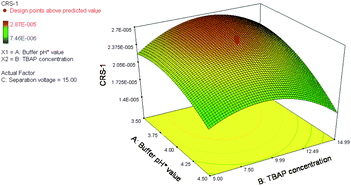Optimization using central composite design for antihistamines separation by nonaqueous capillary electrophoresis with electrochemical and electrochemiluminescence detections
Abstract
The first detailed examination of non-aqueous

* Corresponding authors
a
State Key Laboratory of Electroanalytical Chemistry, Changchun Institute of Applied Chemistry, Chinese Academy of Sciences, Changchun, Jilin, China
E-mail:
youty@ciac.jl.cn.
Fax: +86 431 85262850
Tel: +86 431 85262850
b Department of Chemistry, Hong Kong University, Pokfulam Road, Hong Kong, China
The first detailed examination of non-aqueous

 Please wait while we load your content...
Something went wrong. Try again?
Please wait while we load your content...
Something went wrong. Try again?
X. Li, X. Xu, D. R. Albano and T. You, Analyst, 2011, 136, 5294 DOI: 10.1039/C1AN15730B
To request permission to reproduce material from this article, please go to the Copyright Clearance Center request page.
If you are an author contributing to an RSC publication, you do not need to request permission provided correct acknowledgement is given.
If you are the author of this article, you do not need to request permission to reproduce figures and diagrams provided correct acknowledgement is given. If you want to reproduce the whole article in a third-party publication (excluding your thesis/dissertation for which permission is not required) please go to the Copyright Clearance Center request page.
Read more about how to correctly acknowledge RSC content.
 Fetching data from CrossRef.
Fetching data from CrossRef.
This may take some time to load.
Loading related content
